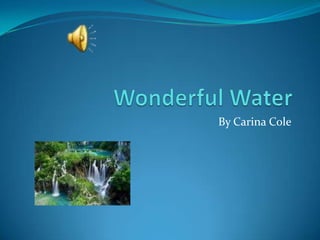
Wonderful waterppp
- 2. Things to know about water… Properties of water The Living Environment Energy & Motion
- 3. Properties of water Students can observe the adhesive and cohesive properties of water. Water is the only substance on Earth that naturally occurs in three different forms. Gas Solid Liquid
- 4. Water is adhesive Water is attracted to some things. Paper towels Water can move up a paper towel Glass Plastic Water does not stick to some things Grease Prevents ducks from getting wet in water Wax Oil
- 5. Water is cohesive Water is attracted to itself. Water can stick together. Water droplets are attracted to each other. Cohesive property causes water to flow without breaking apart.
- 6. Water is a gas Water as a gas can be called… Fog Mist Vapor Steam
- 7. Water is a liquid Rain is a form of water as a liquid. Water can form into droplets. Water can flow.
- 8. Water is a solid Water as a solid is known as… Ice Snow
- 9. Question 1 What are the Click here for three different answer forms of water? Answer
- 10. The Living Environment Water makes our planet uniquely habitable. All living things need water to survive. Plants Animals
- 11. Plants need water All plants need water to survive. Some plants live in the water. Some plants need a lot of water to survive. Some plants survive on little water for long periods of time. Plants take in water through their root system.
- 12. Animals need water All animals need water to survive. Some animals live in the water. Some animals need a lot of water to survive. Some animals can survive without water for long periods of time. Animals intake water through drinking.
- 13. Question 2 What do all Click here for living things answer need to survive? Answer
- 14. Energy & Motion The ability to do work is called energy. Energy is used to do work. The motion of water can be used to do work, thus creating energy!
- 15. Harnessing the power of water Waterwheel Hydroelectric Mills
- 16. Question 3 What are Click here for some ways to answer harness the power of Answer water?
- 17. Resources Colley, K. E. (2006). Understanding Ecology Content Knowledge & Acquiring Science Process Skills. Science Activities , 26-33. Dana, R. K. (1997). Contextualized Science For Teaching Science & Technology. Interchange , 121-144. Google Images Search Morgan, K. A. (2008, December). The Wonder of Water. Science and Children , 16-18.